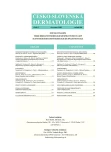-
Medical journals
- Career
Follow-up of Patients with Melanoma
Authors: N. Vojáčková; Z. Kružicová; L. Vrbová; J. Hercogová
Authors‘ workplace: Dermatovenerologická klinika UK 2. LF a FN Na Bulovce, přednosta prof. MUDr. Jana Hercogová, CSc.
Published in: Čes-slov Derm, 86, 2011, No. 3, p. 144-147
Category: Clinical and laboratory Research
Overview
The analysis included patients with melanoma from the group followed at the melanoma clinic of The Department of Dermatology School 2nd Faculty of Medicine and Faculty Hospital Bulovka in the years 1989–2009. Those examined in the year 2009 were included in the study. We evaluated risk factors and photo-type of patients with diagnosed metastasis. Also the appearance of the second primary cancer was assessed.
The whole-life follow-up in melanoma patients is recommended, the frequency of controls depends on the stage of the disease. The aim of the follow-up is an early detection of progression and recurrence of melanoma as well as appearance of other malignanciesKey words:
metastatic melanoma – follow-up – risk factors
Sources
1. DIFRONZO, L. A., WANEK, L. A., MORTON, D. L. Earlier diagnosis of second primary melanoma confirms the benefits of patient education and routine postoperative follow-up. Cancer, 2001, 15, p. 1520–1524.
2. DIFRONZO, L. A., WANEK, L. A., ELASHOFF, R., MORTON, D. L. Increased incidence of second primary melanoma in patients with a previous cutaneous melanoma. Ann. Surg. Oncol., 1999, 6, 7, p. 705–711.
3. DUMMER, R., HAUSCHILD, A., PENTHEROUDAKIS, G. Cutaneous malignant melanoma: ESMO Clinical, Recomendations for diagnosis, treatment and follow-up. Ann. Oncol., 2009, 20, p. 129–131.
4. FERRONE, C. L., BEN, P. L., PANAGEAS, K. S. et al. Clinicopathological features of and risk factors for multiple primary melanomas. JAMA, 2005, 294, 13, p. 1647–1654.
5. GELLER, A. C., SWETTER, S. M., BROOKS, K. et al. Screening, early detection, and trends for melanoma: Current status (2000-2006) and future directions. J. Am. Acad. Dermatol., 2007, 57, 4, p. 555–572.
6. GOLDBERG, M. S., DOUCETTE, J. T., LIM, H. W. et al. Risk factors for presumptive melanoma skin cancer screening: American Academy of Dermatology National Melanoma/Skin Cancer screening Program experience 2001–2005. J. Am. Acad. Dermatol., 57, 2007, 1, p. 60–66.
7. HENGGE, U. R., WALERAND, A., STUTZKI, A. et al. Cost-effectiveness of reduced follow-up in malignant melanoma. JDDG, 2007, 5, p. 898–907.
8. KRAJSOVÁ, I. Melanom. Maxdorf: Praha 2006, s. 336.
9. LEITER, U., GARBE, C. Epidemiology of melanoma and nonmelanoma skin cancer-the role of sunlight. Exp. Med. Biol., 2008, 624, p. 89–103.
10. LIVESTRO, D. P., KAINE, E. M., MICHAELSON, J. S. et al. Melanoma in the Young: Differences and Similarities With Adult Melanoma. Cancer, 2007, 110, 3, p. 614–624.
11. NCCN, Practise Guidelines in Oncology-v. 2. 2010, Melanoma.
12. PSATY, E. L., SCOPE, A., HALPERN, A. C. et al. Defining the patient at high risk for melanoma. Int. J. Dermat., 2010, 49, p. 362–376.
13. SAVOIA, P., QUAGLINO, P., VERRONE, A. et al. Multiple primary melanomas: analysis of 49 cases. Mel. Res., 1998, 8, 4, p. 361–366.
14. STERRY, W., GRIFFITHS, C., KORTING, H. C. et al. Guidelines for Dermatology in Europe. 2009, Berlin, ABW Wissenschaftsverlag GmbH, p. 35–52.
15. ULIASZ, A., LEBWOHL, M. Patient education and regular surveillance results in earlier diagnosis of second primary melanoma. Int. J. Dermatol., 2007, 46, p. 575–577.
16. WEINLICH, G. Metallothionein-overexpression as a prognostic marker in melanoma. G. Ital. Dermatol. Venerol., 2009, 144, p. 27–38.
Labels
Dermatology & STDs Paediatric dermatology & STDs
Article was published inCzech-Slovak Dermatology

2011 Issue 3
Most read in this issue- Pityriasis Rubra Pilaris
- Miliaria Pustulosa
- The Significance of Diagnostic Hypoallergenic Diet in Patients with Atopic Eczema
- Follow-up of Patients with Melanoma
Login#ADS_BOTTOM_SCRIPTS#Forgotten passwordEnter the email address that you registered with. We will send you instructions on how to set a new password.
- Career

